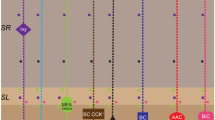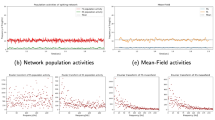Abstract
Computational modeling has played an important role in the dissection of the biophysical basis of rhythmic oscillations in thalamus that are associated with sleep and certain forms of epilepsy. In contrast, the dynamic filter properties of thalamic relay nuclei during states of arousal are not well understood. Here we present a modeling and simulation study of the throughput properties of the visually driven dorsal lateral geniculate nucleus (dLGN) in the presence of feedback inhibition from the perigeniculate nucleus (PGN). We employ thalamocortical (TC) and thalamic reticular (RE) versions of a minimal integrate-and-fire-or-burst type model and a one-dimensional, two-layered network architecture. Potassium leakage conductances control the neuromodulatory state of the network and eliminate rhythmic bursting in the presence of spontaneous input (i.e., wake up the network). The aroused dLGN/PGN network model is subsequently stimulated by spatially homogeneous spontaneous retinal input or spatio-temporally patterned input consistent with the activity of X-type retinal ganglion cells during full-field or drifting grating visual stimulation. The throughput properties of this visually-driven dLGN/PGN network model are characterized and quantified as a function of stimulus parameters such as contrast, temporal frequency, and spatial frequency. During low-frequency oscillatory full-field stimulation, feedback inhibition from RE neurons often leads to TC neuron burst responses, while at high frequency tonic responses dominate. Depending on the average rate of stimulation, contrast level, and temporal frequency of modulation, the TC and RE cell bursts may or may not be phase-locked to the visual stimulus. During drifting-grating stimulation, phase-locked bursts often occur for sufficiently high contrast so long as the spatial period of the grating is not small compared to the synaptic footprint length, i.e., the spatial scale of the network connectivity.
Similar content being viewed by others
References
Babadi B (2005) Bursting as an effective relay mode in a minimal thalamic model. J. Comput. Neurosci. 18(2): 229–243.
Bloomfield SA, Sherman SM (1989) Dendritic current flow in relay cells and interneurons of the cat’s lateral geniculate nucleus. Proc. Nat. Acad. Sci. 86: 3911–3914.
Cai D, DeAngelis GC, Freeman RD (1997) Spatiotemporal receptive field organization in the lateral geniculate nucleus of cats and kittens. J. Neurophysiol. 78(2): 1045–1061.
Casti AR, Omurtag A, Sornborger A, Kaplan E, Knight B, Victor J, Sirovich L (2002) A population study of integrate-and-fire-or-burst neurons. Neural. Comput. 14(5): 957–986.
Coombes S (2003) Dynamics of synaptically coupled integrate-and-fire-or-burst neurons. Physical Rev. E. 67(041910).
Coombes S, Owen MR, Smith GD (2001) Mode-locking in a periodically forced integrate-and-fire-or-burst neuron model. Phys. Rev. E. 64(041914): 1–12.
Cox CL, Reichova I, Sherman SM (2003) Functional synaptic contacts by intranuclear axon collaterals of thalamic relay neurons. J. Neurosci. 23(20): 7642–7646.
Dawis S, Shapley R, Kaplan E, Tranchina D (1984) The receptive field organization of X-cells in the cat: Spatiotemporal coupling and asymmetry. Vision Res. 24(6): 549–564.
Dayan P, Abbott LF (2001) Theoretical Neuroscience: Computational and Mathematical Modeling of Neural Systems. The MIT Press, Cambridge, MA.
DeAngelis GC, Ohzawa I, Freeman RD (1995) Receptive field dynamics in the central visual pathways. Trends in Neurosci. 18(10): 451–458.
Destexhe A, Bal T, McCormick DA, Sejnowski TJ (1996) Ionic mechanisms underlying synchronized oscillations and propagating waves in a model of ferret thalamic slices. J. Neurophysiol. 76(3): 2049–2070.
Destexhe A, Contreras D, Steriade M (1998a) Mechanisms underlying the synchronizing action of corticothalamic feedback through inhibition of thalamic relay cells. J. Neurophysiol. 79(2): 999–1016.
Destexhe A, Mainen Z, Sejnowski T (1994) Synthesis of models for excitable membranes, synaptic transmission and neuromodulation using a common kinetic formalism. J. Computat. Neurosci. 1: 195–230.
Destexhe A, Neubig M, Ulrich D, Huguenard J (1998b) Dendritic low-threshold calcium currents in thalamic relay cells. Neuroscience. 18(10): 3574–3588.
Destexhe A, Sejnowski TJ (2001) Thalamocortical assemblies. Oxford University Press, Oxford.
Gabbiani F, Koch C (1998) Principles of spike train analysis. MIT Press, Cambridge, MA, second edn., pp. 313–360.
Golomb D, Wang XJ, Rinzel J (1994) Synchronization properties of spindle oscillations in a thalamic reticular nucleus model. J. Neurophysiol. 72(3): 1109–1126.
Golomb D, Wang XJ, Rinzel J (1996) Propagation of spindle waves in a thalamic slice model. J. Neurophysiol. 72(2): 750– 769.
Guido W, Lu SM, Vaughan JW, Godwin DW, Sherman SM (1995) Receiver operating characteristic (ROC) analysis of neurons in the cat’s lateral geniculate nucleus during tonic and burst response mode. Vis. Neurosci. 12: 723–741.
Huertas MA, Groff JR, Smith GD (2004) The effect of feedback inhibition on throughput properties of the dorsal lateral geniculate nucleus. In: Proceedings of the 2004 Computational Neuroscience Annual Meeting, Special supplement to Neurocomputing.
Huguenard JR, McCormick DA (1992) Simulation of the currents involved in rhythmic oscillations in thalamic relay neurons. J. Neurophysiol. 68(4): 1373–1383.
Kaplan E, Mukherjee P, Shapley RM (1993) Information filtering in the lateral geniculate nucleus. In: R Shapley and D Lam, eds., Contrast Sensitivity The Cambridge, Massachusetts. MIT Press 5: 183–200.
Kaplan E, Purpura K, Shapley RM (1987) Contrast affects the transmission of visual information through the mammalian lateral geniculate nucleus. J. Physiol. (London) 391: 267– 288.
Krinskii VI, Kokoz IuM (1973) Analysis of the equations of excitable membranes. i. reduction of the hodgkins-huxley equations to a 2d order system. Biofizika 18(3): 506–511.
Lytton WW, Contreras D, Destexhe A, Steriade M (1997) Dynamic interactions determine partial thalamic quiescence in a computer network model of spike-and-wave seizures. J. Neurophysiol. 77(4): 1679–1696.
McCormick DA (1992) Neurotransmitter actions in the thalamus and cerebral cortex and their role in neuromodulation of thalamocortical activity. Prog. Neurobio. 39: 337–388.
McCormick DA, Bal T (1997) Sleep and arousal: Thalamocortical mechanisms. Ann. Rev. Neurosci. 20: 185– 215.
McCormick DA, Huguenard JR (1992) A model of the electrophysiological properties of thalamocortical relay neurons. J. Neurophysiol. 68(4): 1384–1400.
Mukherjee P, Kaplan E (1998) The maintained discharge of neurons in the cat lateral geniculate nucleus: Spectral analysis and computational modeling. Vis. Neurosci. 15: 529–539.
Nykamp DQ, Tranchina D (2000) A population density approach that facilitates large-scale modeling of neural networks: Analysis and an application to orientation tuning. J. Comput. Neurosci. 8(1): 19–50.
Omurtag A, Knight BW, Sirovich L (2000) On the simulation of large populations of neurons. J. Comput. Neurosci. 8(1): 51– 63.
Pape HC, McCormick DA (1995) Electrophysiological and pharmacological properties of interneurons in the cat dorsal lateral geniculate nucleus. Neuroscience 68(4): 1105–1125.
Ramcharan EJ, Cox CL, Zhan XJ, Sherman SM, Gnadt JW (2000) Cellular mechanisms underlying activity patterns in the monkey thalamus during visual behavior. J. Neurophysiol. 84(4): 1982–1987.
Ramcharan EJ, Gnadt JW, Sherman SM (2000) Burst and tonic firing in thalamic cells of unanesthetized, behaving monkeys. Visual Neuroscience. 17: 55–62.
Rinzel J (1985) Excitation dynamics: Insights from simplified membrane models. Fed. Proc. 44(15): 2944–2946.
Rinzel J, Terman D, Wang XJ, Ermentrout B (1998) Propagating activity patterns in large-scale inhibitory neuronal networks. Science 279(5355): 1351–1355.
Rodieck RW, Brening RK (1983) Retinal ganglion cells: Properties, types, genera, pathways and trans-species comparisons. Brain Behav. Evol. 23(3–4): 121–164.
Rush ME, Rinzel J (1994) Analysis of bursting in a thalamic neuron model. Biol. Cybern. 71(4): 281–291.
Sanchez-Vives MV, Bal T, McCormick DA (1997) Inhibitory interactions between perigenicualte gabaergic neurons. J. Neurosci. 17(22): 8894–8908.
Shapley RM, Lennie P (1985) Spatial frequency analysis in the visual system. Ann. Rev. Neurosci. 8: 547–583.
Sherman SM (1996) Dual response modes in lateral geniculate neurons: Mechanisms and functions. Vis. Neurosci. 13: 205– 213.
Sherman SM, Guillery RW (1996) The functional organization of thalamocortical relays. J Neurophysiol. 76: 1367–1395.
Sherman SM, Koch C (1990) Thalamus GM Shepherd, (ed.) In: Synaptic Organization of the Brain, Third Edition, pp. 246–278, New York. Oxford University Press.
Sherman SM, Koch C (1986) The control of retinogeniculate transmission in the mammalian lateral geniculate nucleus. Exp. Brain. Res. 63: 1–20.
Smith GD, Cox CL, Sherman SM, Rinzel J (2000) Fourier analysis of sinusoidally-driven thalamocortical relay neurons and a minimal intergrate-and-fire-or-burst model. J. Neurophysiol. 83(1): 588.
Smith GD, Cox CL, Sherman SM, Rinzel J (2001) Spike-frequency adaptation in sinusoidally-driven thalamocortical relay neurons. Thalamus and Related Systems. 11: 1–22.
Smith GD, Huertas MA, Groff JR (2003) The effect of feedback inhibition in network simulations of retinogeniculate transmission. In Annual Meeting of the Society for Neuroscience, Program no. 68.12.
Troy JB, Robson JG (1992) Steady discharges of X and Y retinal ganglion cells of cat under photopic illuminance. Vis. Neurosci. 9: 535–553.
Van Horn SC, Erisir A, Sherman SM (2000) Relative distribution of synapses in the A-laminae of the lateral geniculate nucleus of the cat. J. Comp. Neurol. 416(4): 509–520.
von Krosigk M, Bal T, (1993) McCormick DA Cellular mechanisms of a synchronized oscillation in the thalamus. Science 261(5119): 361–364.
Wang XJ, Golomb D, Rinzel J (1995) Emergent spindle oscillations and intermittent burst firing in a thalamic model: Specific neuronal mechanisms. Proc. Nat. Acad. Sci. 92(12): 5577–5581.
Author information
Authors and Affiliations
Corresponding author
Rights and permissions
About this article
Cite this article
Huertas, M.A., Groff, J.R. & Smith, G.D. Feedback Inhibition and Throughput Properties of an Integrate-and-Fire-or-Burst Network Model of Retinogeniculate Transmission. J Comput Neurosci 19, 147–180 (2005). https://doi.org/10.1007/s10827-005-1084-6
Received:
Revised:
Accepted:
Issue Date:
DOI: https://doi.org/10.1007/s10827-005-1084-6




